10 Fascinating Viscacha Fun Facts: Unraveling the Enigmatic World of South American Rodents
This post contains affiliate links. This means I will make a commission at no extra cost to you should you click through and make a purchase. Read the full disclosure here.
When we think of the world’s most intriguing creatures, our minds often conjure images of exotic animals from distant lands. Yet, nestled in the high-altitude landscapes of the South American Andes, an enigmatic rodent known as the Viscacha captivates those who venture into its domain. With its fluffy tail, intricate burrows, and social behavior, the Viscacha is a captivating example of nature’s creativity and adaptability.
In this blog post, we’re embarking on a journey to uncover the captivating world of Viscacha. As we delve into the lives of these unique rodents, you’ll discover a range of astonishing traits that set them apart from the ordinary. From their high-altitude habitats to their unexpected communication methods, Viscachas are a treasure trove of surprises waiting to be unveiled. So, join us as we unravel the mysteries and unveil the magic of these fascinating creatures.

Fun Fact 1: High-Altitude Dwellers
Among the breathtaking landscapes of the Andes Mountains, Viscachas have carved out their niche in some of the world’s most extreme altitudes. These rodents are not content with ordinary habitats; they thrive where the air is thin and the conditions are challenging.
Altitude Adaptations: Viscachas’ choice of habitat isn’t arbitrary; it’s a result of remarkable adaptations that allow them to survive in such harsh environments. Their bodies have evolved to make the most of the limited oxygen available, showcasing their ability to conquer altitudes that would be inhospitable to many other creatures.
Elevated Ecosystem Impact: While high altitudes might seem barren and isolated, Viscachas play a crucial role in maintaining the balance of their ecosystem. As primary consumers, their presence influences plant growth dynamics and impacts the lives of other species that depend on these plants for survival.
Beyond the Peaks: The world of Viscachas serves as a reminder that life flourishes in even the most unlikely places. These rodents have mastered the art of thriving where others might falter, making them a testament to the diversity and resilience of life on our planet. As we move on to explore more Viscacha fun facts, prepare to be amazed by the ingenuity of these high-altitude dwellers.
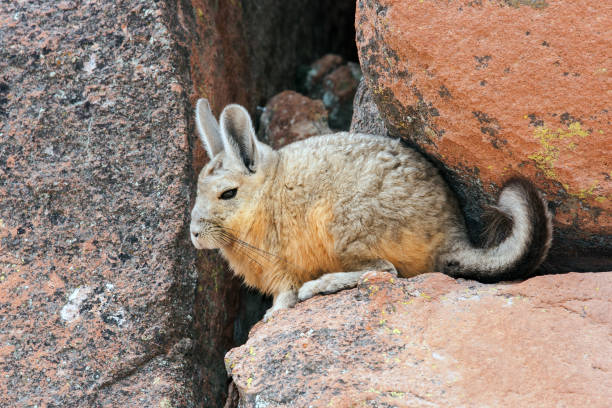
Fun Fact 2: Fluffy Tails and Thermoregulation
Prepare to be charmed by one of the most iconic features of Viscachas – their remarkably fluffy tails. These tails are not just for show; they play a crucial role in helping these rodents regulate their body temperature and adapt to the ever-changing weather of high-altitude landscapes.
Tail Tales: Viscachas’ tails are much more than adorable appendages. When the temperatures drop in the chilly Andean nights, these rodents use their bushy tails as natural blankets, wrapping them around their bodies for warmth. Conversely, on scorching days, they stretch out their tails to release excess heat, acting as a built-in cooling mechanism.
Nature’s Innovation: The tail’s ability to serve both as an insulator and a heat dissipater is a testament to nature’s ingenuity. Viscachas have harnessed this unique adaptation to survive the extreme temperature fluctuations that characterize their high-altitude habitats.
The Fluffy Connection: The next time you catch a glimpse of a Viscacha’s fluffy tail, you’ll know that it’s not just a charming feature but a vital tool for survival. Their tails remind us that even in the animal kingdom, form often follows function in the most fascinating ways. As we journey through more Viscacha fun facts, you’ll find that nature’s designs are full of surprises.
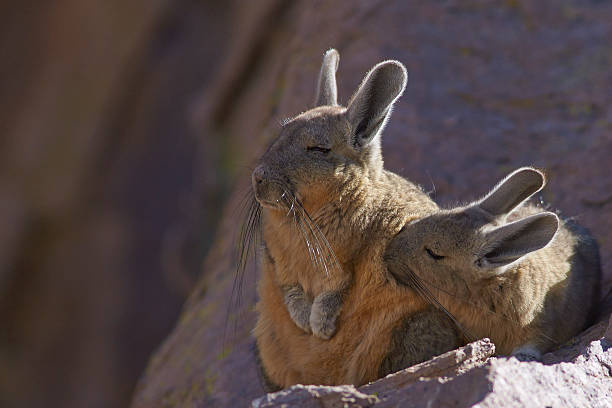
Fun Fact 3: Social Societies
In the seemingly isolated world of high-altitude environments, Viscachas have defied the stereotype of the solitary rodent. These creatures have evolved to thrive in social communities, revealing a level of cooperation and organization that’s nothing short of impressive.
Colonial Cohesion: Viscachas are known for their affinity for living in colonies. These colonies can consist of just a few individuals or expand to encompass dozens. The benefits of colony life are numerous, including increased protection, shared warmth, and communal foraging.
Hierarchy Matters: Within these colonies, Viscachas establish a hierarchy that determines access to resources and mates. Dominant individuals enjoy certain privileges, such as the best nesting spots or priority access to food. This hierarchical system helps maintain order and minimize conflicts within the group.
Social Bonds: Viscachas’ social behavior isn’t just about survival – it’s about building connections. Their interactions involve intricate rituals of communication, cooperation, and even moments of play. Witnessing these interactions is a testament to the complex and rich social lives of these seemingly small creatures.
Bridging the Gap: The social societies of Viscachas are a reminder that even in the most remote corners of our planet, the drive to connect and cooperate is a powerful force. As we continue to uncover more Viscacha fun facts, you’ll discover the nuances of their interactions and the vital role these behaviors play in their survival.
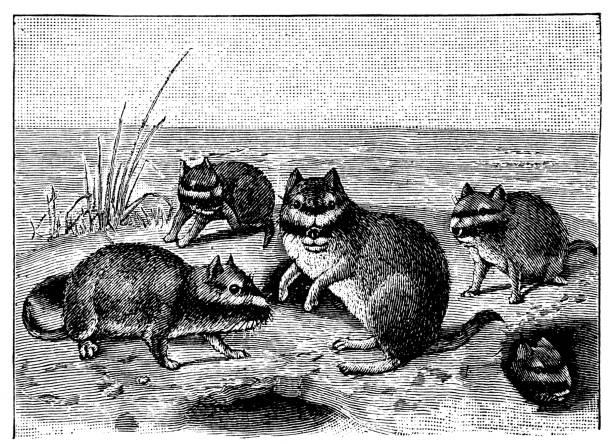
Fun Fact 4: Multilingual Communication
Communication is the cornerstone of any thriving society, and Viscachas have their own unique language that goes beyond words. Their diverse repertoire of vocalizations and body language allows them to convey messages, establish dominance, and maintain harmony within their colonies.
Chirps and Whistles: Viscachas communicate using an array of vocalizations that range from high-pitched chirps to softer, melodic calls. These sounds serve various purposes, such as alerting the colony to potential threats, signaling mating readiness, and coordinating activities within the group.
Body Language: Beyond vocalizations, Viscachas utilize body language to express themselves. They may raise their heads to assert dominance or flatten themselves against the ground to signal submission. These subtle gestures help prevent conflicts and maintain the social harmony of the colony.
Scent Marking: Scent plays a significant role in Viscachas’ communication. They mark their territories and pathways with scent glands located on their bodies, leaving behind olfactory cues that convey information about their identity, status, and presence. This scent marking helps establish boundaries and reduce aggression within the colony.
A Multilingual Colony: Observing Viscachas’ communication methods is a reminder that language takes many forms, and effective communication is vital for cooperation and survival. The richness of their nonverbal language adds yet another layer of complexity to their already fascinating social lives.
As we dive deeper into Viscacha’s fun facts, you’ll discover more about the intricate ways in which these rodents navigate their world and interact with their fellow colony members.
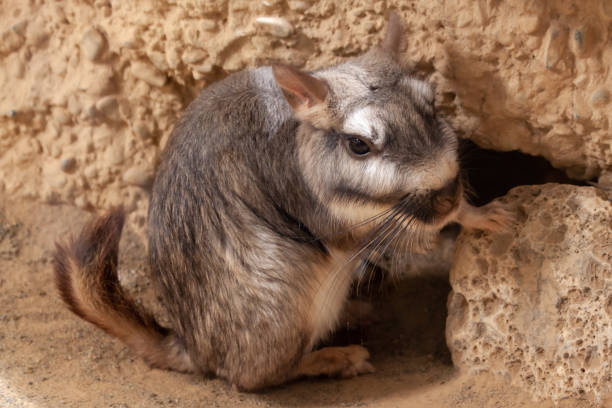
Fun Fact 5: Masterful Burrow Builders
Beneath the rugged landscapes of the high-altitude Andes lies a hidden world of intricate tunnels and chambers – the handiwork of Viscachas. These masterful burrow builders have created subterranean sanctuaries that serve as their homes, nurseries, and even strategic fortresses.
Entrance Engineering: Viscachas are adept at carving out entrances to their burrows in strategic locations. These entrances are often located on hillsides or beneath rocks, providing discreet access points that minimize the risk of predation.
Chambers of Purpose: The burrows themselves are not mere holes in the ground; they are complex networks of interconnected chambers. Each chamber has a distinct purpose, whether it’s a nesting area for raising young, storage space for food, or a designated spot for waste disposal.
Safe Havens: Viscachas’ burrows serve as safe havens from predators such as birds of prey, foxes, and wildcats. When danger looms, these rodents can swiftly retreat into the safety of their underground hideaways, utilizing the intricate tunnels to navigate away from harm.
Temperature Regulation: The burrows also play a role in temperature regulation. In the high-altitude environment, where temperatures can fluctuate dramatically, the burrows provide Viscachas with a stable microclimate. This thermal insulation is particularly crucial during cold nights and scorching days.
Architects of Survival: The remarkable burrows of Viscachas demonstrate their ability to adapt to their environment by utilizing their natural instincts for digging and construction. As we explore more Viscacha fun facts, you’ll uncover the ingenious ways in which these rodents have harnessed their environment to thrive.
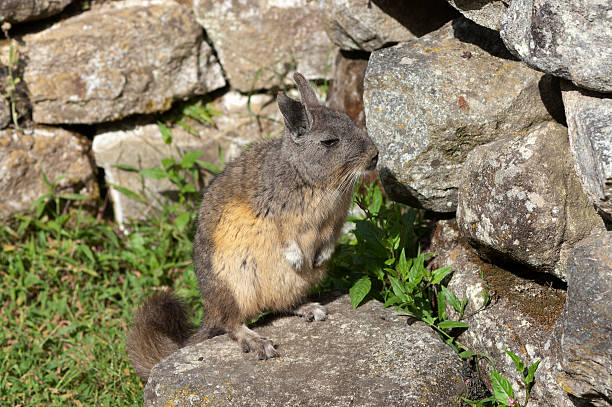
Fun Fact 6: Herbivorous Lifestyle
The diet of Viscachas is as intriguing as their burrow-building skills. These rodents have adopted a herbivorous lifestyle, feasting on a variety of plant matter that sustains them in their high-altitude habitats. This dietary choice not only showcases their adaptability but also reveals their vital role within their ecosystem.
Plant-Powered Palates: Viscachas’ menu consists primarily of plant material, including grasses, leaves, and other vegetation. Their herbivorous diet is well-suited to the available resources in their high-altitude habitats, where plant growth can be challenging due to extreme conditions.
Ecosystem Impact: As primary consumers, Viscachas play a crucial role in shaping their ecosystem. By consuming plant matter, they influence plant growth dynamics and nutrient cycling. Their feeding habits indirectly impact the lives of other species that depend on these plants for food or shelter.
Balancing Act: Foraging for food at high altitudes is no easy feat, given the limited availability of resources. Viscachas have adapted their foraging behavior to optimize energy expenditure. Their selective foraging and energy-efficient tactics showcase their ability to find a balance between sustenance and survival.
A Role in the Web: Viscachas’ herbivorous lifestyle demonstrates the interconnectedness of life within ecosystems. These rodents exemplify how seemingly small creatures can have far-reaching effects on their surroundings. As we delve into more Viscacha fun facts, you’ll discover the delicate dance between Viscachas and the plant life they depend upon.

Fun Fact 7: Oxygen Efficiency
Surviving at high altitudes presents a unique challenge due to the thin air and reduced oxygen levels. However, Viscachas have evolved an array of adaptations that allow them to navigate this challenging environment while maximizing their oxygen intake.
Efficient Respiratory Systems: Viscachas possess highly efficient respiratory systems that enable them to extract more oxygen from each breath. This adaptation helps them thrive in environments where oxygen levels are lower, allowing them to make the most of the limited resources available.
Mastering the Thin Air: Viscachas’ ability to thrive at high altitudes showcases their remarkable physiological adaptations. Their efficient oxygen utilization is a testament to the wonders of nature’s design, allowing them to conquer altitudes that might seem inhospitable to many other creatures.
Impact on Behavior: This unique adaptation not only enables Viscachas to survive but also influences their behaviors. Their deliberate movements and energy-efficient activities reflect the necessity of optimizing oxygen consumption in their high-altitude homes.
An Oxygen-Powered Journey: As we continue to uncover Viscacha fun facts, you’ll find that every aspect of these rodents’ lives is a testament to their exceptional adaptations and their ability to thrive in the face of challenging conditions. Stay with us as we delve into more surprises from the world of Viscachas.
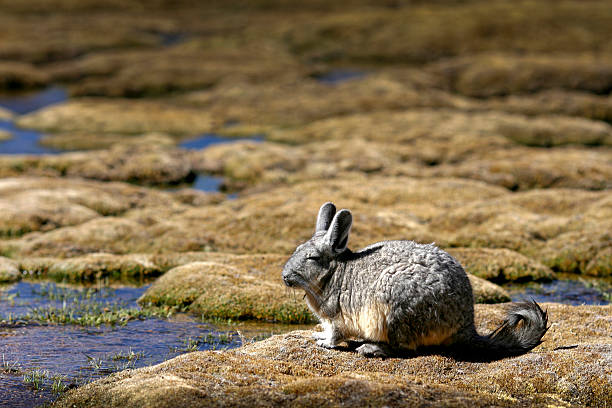
Fun Fact 8: Water-Wise Rodents
Water is a precious resource in the arid landscapes of the South American highlands, and Viscachas have developed water-wise strategies to cope with their environment’s scarcity. Their ability to conserve water and obtain moisture from their diet showcases their resourcefulness in the face of challenging conditions.
Reducing Water Loss: Viscachas possess efficient kidneys that allow them to concentrate their urine, minimizing water loss from their bodies. This adaptation is crucial in an environment where water is in short supply and every drop counts.
Moisture from Food: Viscachas derive a significant portion of their water needs from the moisture present in their herbivorous diet. This adaptation enables them to obtain hydration from the plant matter they consume, reducing their dependency on external water sources.
Surviving on the Edge: Water scarcity is a defining characteristic of Viscachas’ habitats, and their ability to manage this precious resource showcases their adaptability to the challenges of their environment. This water-wise approach contributes to their overall survival and success in high-altitude landscapes.
A Lesson in Adaptation: Viscachas’ water conservation strategies serve as a reminder that even in the most challenging of circumstances, nature finds ingenious ways to adapt and thrive. As we delve deeper into more Viscacha fun facts, you’ll discover how these rodents have harnessed their environment to ensure their survival in the face of adversity.
Fun Fact 9: Environmental Engineers
Viscachas are more than herbivores; they are key players in shaping the environment around them. Their herbivorous lifestyle and foraging behaviors have a profound impact on their ecosystem, making them not only consumers but also environmental engineers.
Vegetation Managers: By consuming plant material, Viscachas exert control over plant growth dynamics in their habitat. Their grazing behavior prevents overgrowth and maintains a balanced ecosystem where various plant species can coexist.
Nutrient Cyclers: As primary consumers, Viscachas play a critical role in nutrient cycling. The nutrients they obtain from plants are transferred up the food chain as they become prey for predators, contributing to the overall health of the ecosystem.
Ecosystem Influence: Viscachas’ role as an environmental engineer underscores the intricate web of interactions that define their habitat. Their actions create a ripple effect that touches countless other species, highlighting the interconnected nature of life in their high-altitude world.
A Subtle Impact: Viscachas’ influence on their environment is a reminder that every creature, no matter how small, plays a part in maintaining the balance of nature. As we journey through more Viscacha fun facts, you’ll discover the intricate dance between Viscachas and the ecosystem they call home.
Fun Fact 10: Conservation Considerations
While Viscachas have proven their adaptability to the challenging conditions of their high-altitude habitats, they face a new set of challenges in the form of human activities and environmental changes. Understanding these threats is crucial for developing effective conservation strategies to protect these unique creatures and their delicate ecosystems.
Habitat Loss: Rapid urbanization, agricultural expansion, and deforestation are encroaching upon Viscachas’ natural habitats. As their homes are transformed into human settlements or cleared for agriculture, Viscachas are losing the spaces they need for survival.
Climate Change: The already harsh conditions of the high-altitude environments are being exacerbated by climate change. Rising temperatures and altered precipitation patterns can impact the availability of food and water resources, posing additional challenges for Viscachas’ survival.
Introduced Predators: Introduced predators, such as domestic dogs and cats, pose a significant threat to Viscacha populations. These predators often lack natural predators in the region, leading to increased predation on local wildlife, including Viscachas.
A Call to Action: Recognizing the challenges Viscachas face is the first step toward conservation. By raising awareness about these threats and their implications, we can foster a sense of urgency and encourage collective efforts to protect these remarkable rodents and the ecosystems they inhabit.
Preserving the Legacy: The conservation of Viscachas is not just about protecting a single species; it’s about preserving the intricate tapestry of life that thrives in the South American highlands. By taking action now, we can ensure that these unique creatures continue to contribute to the beauty and diversity of our planet’s landscapes.

Final Thoughts
As we conclude this exploration, we’re reminded that the fate of these creatures rests in our hands. By championing their conservation, we become stewards of not only the Viscachas’ world but also the delicate balance of life on Earth. Let their story inspire us to take action, stand up for the preservation of our planet’s treasures, and ensure that the legacy of Viscachas endures for generations to come.









